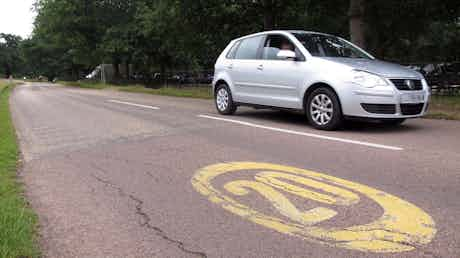Life in the slow lane: do 20mph speed limits work?
July 28, 2022 by Hugo Griffiths

More and more areas of the country are seeing 20mph replace 30mph as the default urban limit; we investigate
The UK national speed limit in urban areas has been 30mph since 1935, yet over recent years 20mph limits have been announced or introduced in several areas, with the Welsh government recently announcing all urban roads would by default have 20mph limits.
This represents a significant change, and it’s one that warrants analysis – not least because evidence surrounding the effectiveness of 20mph limits is complex.
20mph limits: history

The first 20mph speed limit was introduced in the UK in 1991 in Tinsley, Sheffield, with a further 450 20mph limits brought in across the country by the turn of the millennium.
Many of these limits were introduced in London, where a quarter of all roads were 20mph by 2015, while in 2020 all roads within the central Congestion Charge zone were set to 20. Transport for London intends to roll out 20mph limits across 137 miles of road by 2024.
It’s not just London that has been turning to 20, either. In September 2023 all urban roads in Wales will be 20mph by default, while Scotland has said it intends for 20mph to be the standard limit in urban areas by 2025.
20mph limits: the case for
Proponents of 20mph limits highlight several advantages. The main one concerns potentially improved road safety, particularly for pedestrians, cyclists and other vulnerable road users. In 2021, 16,608 pedestrians were injured and 364 killed on UK roads, while 16,479 cyclists were injured, and 113 were killed. Because 30mph zones tend to be set in places where there are high levels of vulnerable road users, around 58% of all accidents take place on roads with this limit.

The argument for changing 30mph limits to 20mph ones is therefore pretty simple: the more slowly a car travels, the less kinetic energy it carries, so the less damage it causes in a collision. Plus, because stopping distances are shorter at lower speeds, the chances of having a collision in the first place are reduced; a driver’s visual field also widens the more slowly they go, allowing those travelling at 20mph to see more than those doing 30mph.
These aspects are played out in collision data: a 2005 study found that only 5% of pedestrians hit at 20mph were killed, compared to 50% hit at 30mph. Other studies have shown that a 1mph reduction in average traffic speed is associated with a 5%-6% drop in injury-causing collisions.
A 2018 study carried out for the Department for Transport (DfT) on 20mph limits found 81% of cyclists, and 75% of residents living in areas with 20mph limits support the schemes, while 66% of non-resident drivers did too. Only 44% of residents in neighbouring areas with 30mph supported 20mph limits, though, with support falling to just 29% among motorcyclists.
Studies of specific schemes where 30mph limits have been replaced by 20mph ones have shown safety benefits. Roughly 94% of the roads in Portsmouth saw their limits reduced from 30mph to 20mph in 2007, a move that correlated with an average speed reduction from 19.8mph to 18.5mph, together with a 21% reduction in reported road injuries.
20mph limits are also said to make vulnerable road users feel safer, encouraging people to walk or cycle, and reducing car use and traffic in the process – although the data on this is less clear-cut.
20mph limits: the case against
One of the biggest problems with 20mph limits is that almost nobody obeys them. Official Government statistics show that in 2021, 87% of drivers broke 20mph speed limits. Compare that to 30mph limits, where 51% of drivers exceeded that speed, and it’s clear that compliance in 20mph limits is poor.
Furthermore, changing a speed limit to 20mph from 30mph brings about only a very small reduction in speed. The 2018 study for the DfT – described at the time as “the largest, most comprehensive and sophisticated study into the effects of 20mph speed limits to be undertaken in the UK” – found that drivers’ median speed fell by just 0.7mph in residential areas, and 0.9mph in city centre areas where limits had been dropped from 30mph to 20mph.

The study also found “no significant change in short term in collisions and casualties in the majority of case studies”, while reporting that the majority of residents “have not noticed a reduction in the speed of vehicles, and do not perceive there to be fewer vehicles driving at excessive speeds”.
The same study found the introduction of 20mph limits increased journey times by 3% in residential areas, and 5% in city-centre areas.
Another issue surrounding 20mph limits is that because they are so widely flouted, they have the potential to undermine the rules of the road. After all, if almost everyone is breaking the law, what does that say about the strength of and respect for the law on a wider basis?
During consultation to introduce 20mph limits in Witney, Oxfordshire, a traffic management officer working for Thames Valley Police warned: “compliance with 20mph limits is a challenging issue”, and added: “If a speed limit is set too low and is ignored then this… could bring the system of speed limits into disrepute.” The officer also warned setting limits too low “can also cause a disproportionate number of drivers to criminalise themselves.”
Guidance from the DfT, meanwhile, states that introducing a 20mph limit is most effective when average vehicle speeds are already 24mph or less, indicating that they may not be effective as a universal urban limit.
Are 20mph speed limits enforceable?
Yes, is the short answer: if you break a 20mph speed limit, you are as liable for a speeding penalty as you would be had you broken any other speed limit. London’s Metropolitan Police has previously said it uses the standard ‘10% +2mph’ threshold for enforcing.

As one example, between 2016 and 2019 in Islington, London, 7,972 people were caught speeding in 20mph limits by speed cameras, while a further 327 tickets were issued by police officers.
Anecdotally though, speed cameras may not seem as prevalent on roads with 20mph limits as they do on other roads, and this may be linked to the fact that 20mph limits are supposed to be “self enforcing”.
This means that the nature of the road and other traffic measures (such as speed humps or cushions, width restrictions or ‘build outs’) are designed to make 20mph feel like the natural speed at which to travel. Such designs are known as 20mph zones rather than 20mph limits.
20mph limits: what’s the answer?
There is clearly a balance to be struck between speed, convenience and safety. If we lowered the urban speed limit to 1mph collisions would all but disappear, but so would any meaningful movement of traffic.
Yet while 20mph limits have been shown to reduce speed, and in some instances reduce casualties among vulnerable road users, concerns about compliance are valid, not least for the potential perception that the widespread contravention of 20mph limits cheapens the rule of law.
The answer may therefore lie not in 20mph limits, but in 20mph zones: urban areas where street design leads to drivers naturally adjusting their speed to a lower limit. Rather than erecting 20mph speed-limit signs, these zones typically require expensive street redesign and traffic-management techniques that reduce drivers’ speeds, without unduly hampering progress.
But while research indicates that introducing 20mph zones instead of 20mph limits has a greater impact on vehicle speeds and accident statistics, there is also evidence that zones are significantly less popular with road users.
Concerns about unpredictable driving – such as people speeding up between speed cushions, or weaving at speed around chicanes – as well the potential for such measures to increase road noise and pollution – mean such zones need careful planning, and should arguably be implemented where appropriate, rather than a blanket approach being taken.
Looking for an easy way to change your car? Then carwow is the place to go. You can sell your car online for a great price, and get the best deals on a new one. All through our network of trusted dealers and all from the comfort of your home. Tap the button below to get started today.















